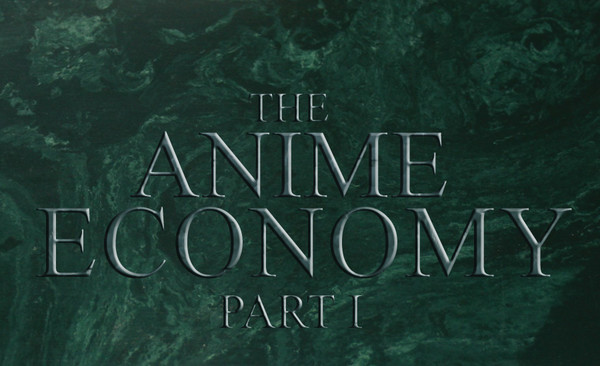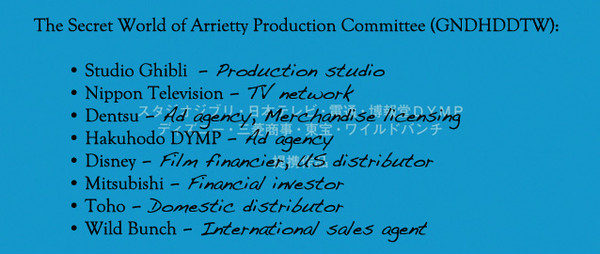The Anime Economy - Part 1: Let's Make An Anime!
by Justin Sevakis,Part 2: Shiny Discs
Part 3: Digital Pennies
Every anime fan, at one time or another, daydreams about making an anime. It's not an uncommon sight to see younger fans toiling over their own original manga, fantasizing that one day it might get an animated TV show.
And yet few of us really has any idea what it takes to make an anime, and what happens each and every time a new show gets off the ground. We see a bunch of names and companies scroll by in the credits, and though we have a general idea of how animation works, and how a show literally gets made, few fans really understand the power behind producing a show. What idea will get animated? What manga or game will see an adaptation? Who will produce the animation? And how will everyone get paid?
The truth is, producing an anime is a herculean task: a gigantic amount of money and manpower get poured into every production well behind the scenes, before a single drawing is even created. The stakes are huge for every company involved, and every season will have a number of winners and losers.

Part 1: Let's Make An Anime!
Who decides to make a show? Usually it's a producer at a company that already has a production office. Most of the bigger manga publishers have one of these, as do several specialty companies like Bandai Visual or Media Factory. And usually the idea isn't necessarily to make a great, stand-alone TV series, it's more about building a marketing opportunity.
And the ways a producer can build opportunities like this can be myriad. The vast majority of anime is not an original story, but is based off of another art form: manga, PC games, or light novels. With an anime on TV, even in a late-night time slot, the increased visibility can really give sales of those original works a boost.
In other cases, a media company will set about creating a new original work that can potentially make money in any number of ways: a popular show can be used to sell toys and model kits, or perhaps the company is really trying to sell a card game (like with Yu-Gi-Oh!). More often, their goal is to simply sell as many DVDs as possible.
Other times, ad agencies like Dentsu and Asatsu DK might decide to produce an anime. Their goal is to use a show as a commercial for their client -- which is why you might see a show aimed at kids stop for a few minutes each week to show off a product, from toys to pizza. There have even been a few cases of religious groups funding anime to promote their faith.



Kodocha was co-produced by ad agency ADK, who brought in toy manufacturer TOMY as a sponsor. The result was some pretty obvious product placement. Meanwhile Superbook was produced by Dentsu on behalf of a church. It's literally an ad for Christianity.
Once a decision is made to try to get a project off the ground, and the creator of the original work is on board, the job of the producer is to find as much money to make the show as possible. 99% of the time, this means starting something called a Production Committee.
Enter the Production Committee
Anime production is an extremely labor-intensive proposition, employing the services of up to 2,000 people per episode around the world. Most of the grunt work is now done in third world countries across Asia, and the use of digital technology has reduced costs across the board. Anime production is now as efficient as it's ever been.
That said, a single anime episode costs about US$100,000-300,000 per episode, according to various producers we've talked to. That might seem like a lot, but in reality it's pretty cheap, about on par with an American deep-cable TV show. (An American prime-time TV show can cost well into the millions.) But multiplied across 13 episodes, that nonetheless turns into a total budget of US$2-4 million.
That's a lot of money. Few companies are rich enough to invest that much in a single show. If it tanked and they lost all that money, most would never be able to recover.
It used to be, back in the 80s when Japan was flush with money, a company would just decide to make a one- or two-part OAV. They'd throw a few hundred thousand dollars at an animation production company, and the production company would haphazardly churn out an OAV. They'd release it on video, a few thousand rental shops across Japan would buy copies, and the show would turn a tidy profit. Or if a longer series seemed possible, the TV networks would pay most of the cost, and support the show with commercials.
Those days are long gone. The collapse of Japan's bubble economy hit the rental market hard, and media companies stopped feeling so adventurous about making direct-to-video content. The TV networks also drastically cut the number of shows they're willing to spend money on, since most anime don't bring in ratings, and it's far cheaper for them to just make another cheap talk show. So, in the early 90s, anime producers faced a challenge: how would they keep getting investment to make new shows?
The answer, it turns out, was to join forces with other companies, and form what's called "Production Committee," or Seisaku Iinkai. The producer meets with other companies that could also benefit from a show being made, and tries to convince them to chip in.
So let's say a manga publisher is trying to get their hottest series animated. Maybe they can get a DVD publisher to chip in. Maybe a video game company could throw in a few bucks, or an ad agency who could sell product placement in the show, or a record label that wants to promote a new artist in the opening and ending. After a lot of meetings and a whole lot of Powerpoint presentations, eventually four or five companies sign up as investors, and the production is a go. This is actually very similar to how Independent Films get made.

And so every couple of weeks, the Production Committee, featuring representatives of each company, gets together and reports on how things are going. They discuss release plans, audience, important plot points, and where the story might deviate from the original. They discuss the marketing, plans for release overseas, and every other detail you could possibly imagine.
The Gensakusha Almighty
Not every member of the Committee gets equal say in every matter, and most of them wouldn't want oversight over everything anyway. (A toy maker wouldn't care about who gets American publishing rights, for example.) One member, however, holds a huge amount of power, by Japanese law: the gensakusha, or original creator, usually a manga artist, gets final say over every major decision.
While this sounds very fair, and nice for the artist, the system doesn't quite work the way it's designed. Manga artists tend to spend most of their time hunched over their drawing desks, and tend to not be all that business savvy. So rather than distract them from their work, their management (their publisher, typically) will act as their agent. That company will have a staff dedicated to making sure everything is to the artist's liking.
Some of those companies are easier to deal with than others. As one could imagine, having the power to approve literally everything related to a show can breed its share of difficult people. Some have odd requests for the property, ranging from the quite reasonable (Shuiesha insists that none of Naruto's hair spikes ever be even slightly cropped off) to the frustrating (such as insisting on a terrible or outright wrong translation), to the outright bizarre (the manga artist must be invited to the Oscars if this gets an American release).
There is no way of knowing what demands are actually the creator's, and what are simply the demands of an obstinate salaryman trying to exert control over the process. And ultimately, it doesn't matter which it is: the artist has legally assigned their rights to this company, for better or worse, and any feuding between the two is done behind closed doors.
This system also doesn't guarantee the artist will be pleased with the final result. If a show's director is going in a direction the manga artist doesn't like, they really have limited options to do anything about it. The contracts are signed, and it's too late to pull out of the project. Other times, the production will forget to ask about every little thing, such as Kyo's bracelet in Fruits Basket (which was intended to be red and white, not black and white, for reasons that were not yet explained in the manga). The only thing an angry gensakusha can do is drag their heels and be a giant pain in the butt about everything that requires their approval.

There are a lot of rumors about the production of Fruits Basket, but the coloring of Kyo's bracelet was inarguably a mistake.
Other issues come up as well. Production committees can often become dysfunctional, and so even small decisions can result in endless political delays and hand-wringing. Major financial decisions, outside-the-norm ideas, and politics can utterly paralyze a production committee, preventing business deals from happening, and essentially shooting the whole production in the foot.
But if all goes well and everyone stays happy, consensus can be reached and things can move forward. Eventually, the committee books some late-night TV air time in various markets (sort of like an Info-mercial), hires an animation staff (the "Animation Producer"), and the show starts to get made.
Keeping the Eye on the Money
Once things get going, the producer has two basic responsibilities: make sure that the show is made well, and recover all the millions of dollars that the Production Committee spent in the first place.
No mother dreams of having an ugly baby, and yet ugly babies are born with astonishing regularity. Likewise, no producer dreams of making a terrible show, and yet they happen all the time. These days, most producers are rather hands-off when it comes to the creative decisions behind a show -- they often haven't gone to film or animation school, and so they'd much rather leave that to the talent.
This is a big difference between the American and Japanese production systems, and it has its plusses and minuses. On the plus side, the show can take on wild, creative directions that make it better. On the downside, however, a director can often follow an instinct that leads them to inject completely inappropriate material into a show, or bog down the pacing with shots that don't fit the narrative.

Most American producers would never allow a children's film to run 2 1/2 hours long.
But more often than not, the director just blows his deadlines, causing the entire production to run late. There have been incidents where the final master tape shows up at the TV studio only hours before it airs! Sometimes the production delays get so bad, the producer has no choice but to allow a hastily-edited recap episode to be inserted, buying the crew an extra week. (Recap episodes are seldom planned, and usually indicate chaos behind-the-scenes.)
Making a good show that appeals to a lot of people, and marketing that show well, is pretty much the only way most anime can hope to ever make back its production cost. The fans have to enjoy the show enough to support it, either with DVD purchases, or in buying merchandise. Once it's released and "in the wild," the producer can really only sit and wait to see what the ratings are like, how the feedback is, and eventually, how the sales numbers are.
By this point the producer probably is also supplying the show to international web streaming services, such as Crunchyroll or Funico. The staff has to work overtime to be able to send them the final show in a secure way, and get them everything they need to market the show effectively. We'll get more into streaming in a later article.
If a show seems to be doing decently, the producer can then take a popular show, and try to keep selling rights to it. Perhaps a game or a toy manufacturer will be more interested, knowing the show's already a hit.
Finally, the producer can sell international DVD rights to a show. This used to be a big deal, but unfortunately is not the boon to the show's bottom line that it was back in the mid-2000s. But it can still be an important step on the road towards breaking even.
Profit or Loss?
Very few shows are runaway successes. Initial sales are a good indicator of whether a show will make back the Production Committee's investment, but in truth, most shows take several years to break even. One longtime anime executive estimated that, given enough time, a good 70% of all anime eventually turn a profit. This happens over years of TV reruns, back catalog DVD sales, and re-releases internationally. The process is seldom rewarded quickly.
The hope is that the remaining 30% that will never make back their budgets will get paid for by the successes. This is a gamble, but it's the most essential one of every entertainment industry: a few huge hits that subsidize tons of losers.
Next time, we'll take a look at how DVD sales, both in Japan and abroad, can be the most important factor in a show's success.
Note: Figures given are estimates and do not necessarily reflect any single release.
Kodocha ©1996 Miho Obana/Shueisha • TV Tokyo • NAS
Fruits Basket ©2001 Natsuki Takaya/HAKUSENSHA • TV TOKYO • NAS • Furuba Project
Superbook © The Christian Broadcasting Network
Evangelion © GAINAX / Project EVA • TV Tokyo
Welcome to THE SPACE SHOW © A-1 Pictures
Cover photo by 401K
discuss this in the forum (103 posts) |
this article has been modified since it was originally posted; see change history